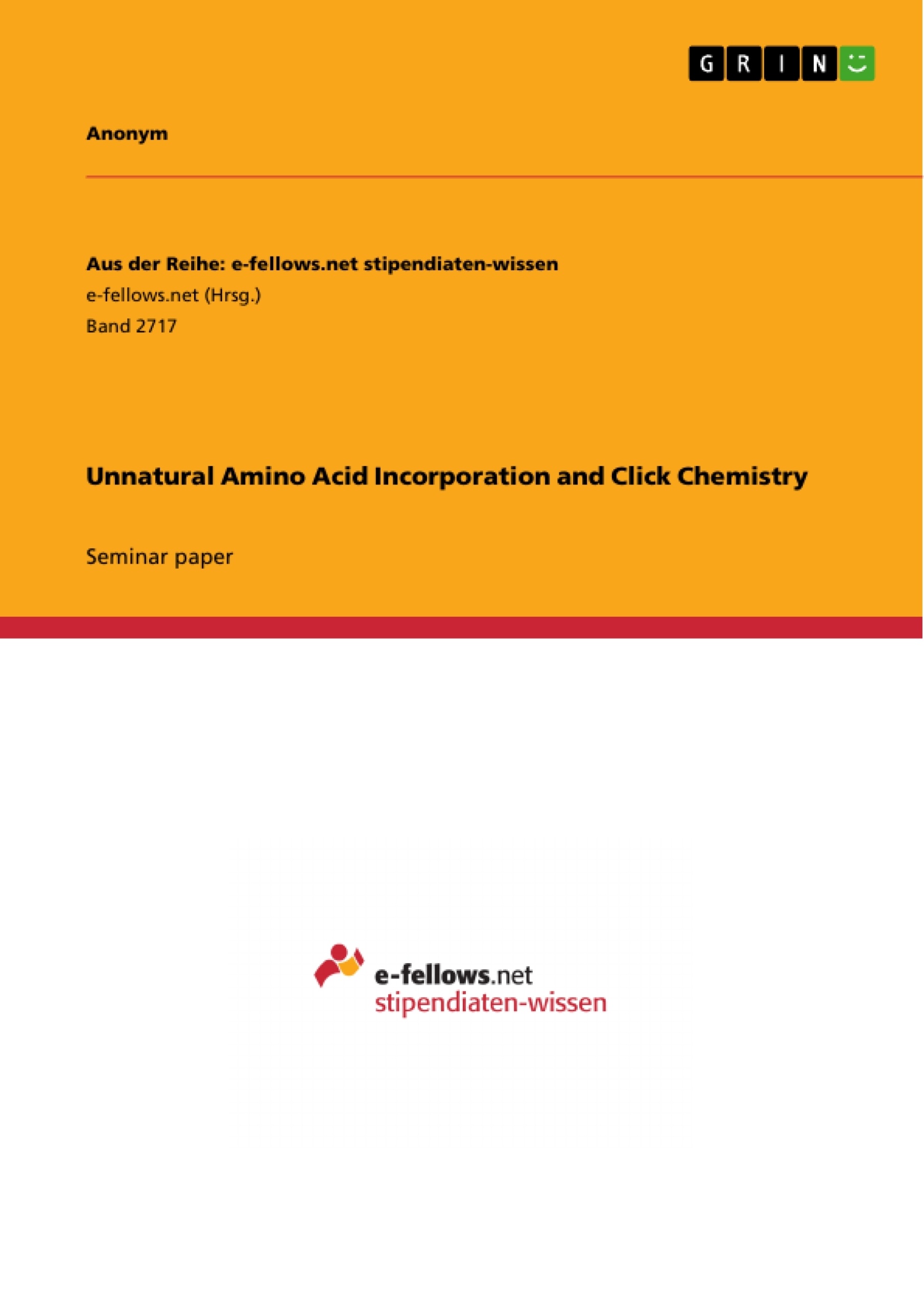In the present work a modified version of yellow fluorescent protein containing an unnatural structural homologue of the natural amino acid pyrrolysine with a norbornene moiety was produced by expression in Escherichia coli. The incorporation of the unnatural amino acid was achieved by amber stop codon suppression method. A bio-othogonal click reaction was performed, binding a synthetic fluorescent dye to the modified protein. All steps towards necessary for obtaining the genetically modified organism were performed and documented. The artificial amino acid, as well as the dye used in the click reaction were synthetically prepared. The success of the project was demonstrated by LC/MS studies of the products. Fluorescence spectroscopy of click reaction product and the protein was performed, but no conclusive proof of FRET effects could as yet be made. This point remains of interest for future studies.
Inhaltsverzeichnis (Table of Contents)
- Abstract
- Glossary
- 1 Introduction: Oligonucleotide Synthesis
- 2 Objective
- 3 Procedures and Materials
- 3.1 Chemistry
- 3.1.1 Methods and Materials utilized
- 3.1.2 Syntheses
- 3.2 Biology
- 3.2.1 Methods and Materials utilized
- 3.2.2 Primer Synthesis
- 3.2.3 Plasmid Mini Prep
- 3.2.4 Agarose Gel Electrophoresis
- 3.2.5 Polymerase Chain Reaction
- 3.2.6 Ligation
- 3.2.7 Transformation
- 3.2.8 Colony PCR
- 3.2.9 Protein Expression
- 3.2.10 Protein Purification
- 3.2.11 SDS-PAGE
- 3.2.12 Protein Digest
- 3.2.13 Protein Click Reaction
- 3.1 Chemistry
- 4 Results and Discussion
- 4.1 Agarose Gel Electrophoresis
- 4.2 SDS PAGE
- 4.3 Fluorescence Spectroscopy
- 4.4 Mass Spectrometry
- 4.4.1 MALDI-TOF
- 4.4.2 LC / MS
- 5 References
Zielsetzung und Themenschwerpunkte (Objectives and Key Themes)
This study aims to achieve bacterial expression of a modified version of yellow fluorescent protein (YFP), a well-known derivative of the green fluorescent protein (GFP) from the jellyfish, Aequorea victoria, capable of binding in a bio-orthogonal manner to a fluorescent molecule. The goal is to introduce bio-orthogonal reactivity into YFP by incorporating a synthetic structural homologue of the natural amino acid, pyrrolysine, at a defined position in the amino acid sequence of the protein. This is achieved by means of amber stop codon suppression technique. The pyrrolysine derivative used for this purpose possesses a norbornene moiety, which readily undergoes cycloaddition reactions. This allows for a bio-orthogonal click reaction with tetrazines under mild conditions suitable for proteins.
- Unnatural amino acid incorporation via amber stop codon suppression
- Bio-orthogonal click chemistry using norbornene and tetrazine moieties
- Fluorescence resonance energy transfer (FRET) between YFP and a rhodamine dye
- Solid-phase oligonucleotide synthesis for primer design
- Bacterial expression and purification of modified YFP
Zusammenfassung der Kapitel (Chapter Summaries)
Chapter 1 provides a comprehensive overview of oligonucleotide synthesis using the phosphoramidite method, a technique crucial for the preparation of custom-designed primers for PCR. The method involves sequential coupling of nucleoside units to a growing polymer chain on a solid support. The synthetic cycle is described in detail, emphasizing the importance of protecting groups and reaction conditions for ensuring high yield and accuracy.
Chapter 2 outlines the objective of the study, which is to express a modified version of YFP in Escherichia coli cells. The modification involves incorporating a synthetic pyrrolysine derivative with a norbornene moiety into the protein sequence. This norbornene group allows for a bio-orthogonal click reaction with a tetrazine-modified rhodamine dye, potentially leading to FRET effects. The preparation of the norbornene amino acid, the tetrazine-TAMRA fluorophore, and a fluorescein dye with a norbornene residue are described.
Chapter 3 details the procedures and materials used in the study. The chemical synthesis of the norbornene amino acid and the tetrazine-TAMRA fluorophore are described, along with the preparation of the fluorescein dye with a norbornene residue for comparison purposes. The biological methods, including primer synthesis, plasmid mini prep, agarose gel electrophoresis, PCR, ligation, transformation, colony PCR, protein expression, protein purification, SDS-PAGE, protein digest, and protein click reaction are all discussed. The chapter also includes tables summarizing the compositions of various media and buffers used in the experiments.
Chapter 4 presents the results and discussion of the study. The successful PCR of the YFP coding sequence and the optimization of PCR conditions are discussed, along with the successful cloning of the YFP gene into the pET28a(+) vector. The results of colony PCR, demonstrating successful transformation, are shown. The protein expression and purification steps are described, including the challenges and strategies used to overcome them. The results of SDS-PAGE analysis are presented, showing the successful expression and purification of both wildtype and amber YFP. Fluorescence spectroscopy data are analyzed, showing evidence of potential FRET between YFP and the TAMRA dye. The results of mass spectrometry analysis, confirming the successful incorporation of the unnatural amino acid into the YFP protein, are discussed.
Schlüsselwörter (Keywords)
The key focus topics of this text include unnatural amino acid incorporation, bio-orthogonal click chemistry, fluorescence resonance energy transfer (FRET), solid-phase oligonucleotide synthesis, bacterial expression, protein purification, and mass spectrometry. The study utilizes the amber stop codon suppression technique to introduce a synthetic pyrrolysine derivative with a norbornene moiety into the YFP protein. The norbornene group undergoes a bio-orthogonal click reaction with a tetrazine-modified rhodamine dye, leading to potential FRET effects. The study also emphasizes the importance of primer design, plasmid cloning, bacterial transformation, and protein analysis techniques.
- Arbeit zitieren
- Anonym (Autor:in), 2014, Unnatural Amino Acid Incorporation and Click Chemistry, München, GRIN Verlag, https://www.hausarbeiten.de/document/416795


